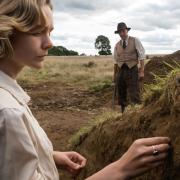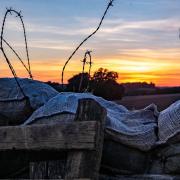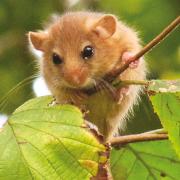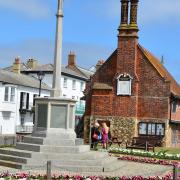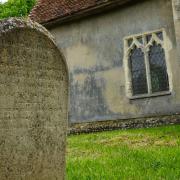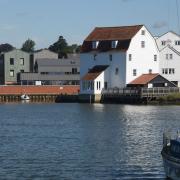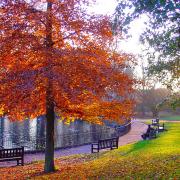Nature writer Matt Gaw discovers how wildflowers and insects are benefiting from grass verges going uncut during Covid-19 on 106 new roadside nature reserves, from Mildenhall to Yoxford, Fressingfield to Flowton

The wind is building, teasing the few thin clouds apart until they look like carded wool against the blue sky. I keep to the right, my feet scuffing in the dust and the grit of the lane, but there are few cars to worry about here. Lockdown has emptied the roads around this part of Suffolk with traffic at its lowest levels since 1955.
No, today I’m staying close to the verge for a very different reason – to try and see wildlife. While many of the special places we usually visit to experience nature are closed or out of reach, the many miles of land that make up the county’s road verges remain resolutely open and, as I have recently found, full of wild wonders.
I admit, I had previously played little attention to verges. They were a green haze half-seen from a car window, ignored in the rush of unthinking movement. Yet this habitat is as important as it is overlooked. While the intensification of farming has seen Suffolk lose more than 90 per cent of its species-rich grassland since the 1930s (the figure is around 97 per cent UK-wide) parts of this old country of meadows and flower-studded fields has managed to cling on. Wildflowers, in effect, hopped over fences, tip-toed through hedges and were carried on the breeze of our own motorised progress to grow on roadside verges. According to the wild plant conservation charity Plantlife, the UK’s 238,000 hectares of roadside verges (to put this into perspective, there are just 85,000 hectares of grassland remaining) support more than 700 species of wildflowers – 45 per cent of our total flora – 100 of which are threatened with extinction.
The verge I am walking along now is one of the 106 sites designated as a Roadside Nature Reserve by Suffolk County Council, meaning it is carefully managed to protect the species that flourish here. For the past eight or nine weeks I have been visiting this 200 metre curve of wildness, along with many other stretches of verge within walking and running distance of my Bury St Edmunds home.
The cowslips that first caught my eye have gone over now, their yellow petals browning and shrinking back to reveal stamens that loll like the tongue of a panting dog. The early purple orchids are also dying back, the softness of their hot pink blooms now tissue-paper dry. But other species are hitting their peak. In the thicker grass closer to a hawthorn hedge, common vetch scrambles to be seen: its small purple-pink flower pea-like and perfect. Closer to the road, clumps of common comfrey are also in flower, their bell-shaped blooms tolling silently in the wind. The colour of them is simply incredible – a Portugese man o’ war purple that provides pain-relief rather than poison. For at least 2,000 years common comfrey, also known as bruise wort, boneset, knitbone, knit back or, simply, the healing herb, was used externally to treat all manner of ailments. The name comfrey is itself derived from the Latin confirmare, meaning to join together. Right now, it is just a sight for sore eyes.
Discover 10 of the prettiest spots in Suffolk for a picnic and a walk
I turn left and start to follow another verge where I’ve heard that pyramid orchids have been recorded, but it seems I’m too early. I stop and look at a poppy, petals blowing like washing on a line, and think how in the following weeks, whether in a designated roadside reserve or in the many miles of verge elsewhere, there will be even more colour – the ever-foaming spokes of cow parsley, ox-eye daisies, red campion, blue harebell and (of course) more orchids. These are plants that are beautiful to look at, but which are also vital sources of food for bees, butterflies, birds, bats and bugs.
Take, for example, bird’s-foot-trefoil, whose yellow slipper-shaped flowers are a common sight on verges from May until September. This one species of plant provides food for 160 kinds of insect. In fact, just one hectare of road verge can produce 60kg of nectar sugar – enough to support more than 6 million bees. One of the things I first noticed during my lockdown walks was how the roadsides hummed with the sounds of bees and flies.
What’s more, the impact of Covid-19 could actually make these fragments of grassland wilder still. As local authorities across the country divert resources to frontline services, many verges are being left uncut, allowing species that are often destroyed in April and May mowings, to bloom for the first time in living memory. A couple of weeks ago, I spoke to Dr Trevor Dines, a botanical specialist at Plantlife, who said the charity was seeing more people reporting verges covered in wildflowers. In one case, 40 early purple orchids were seen on just one small stretch of verge.
At a time when we need to find beauty in the small things, noticing the health of these wild places also impacts on our own wellbeing. Research has shown us again and again that interactions with the natural world can change our biochemistry, reducing stress hormones, increasing beneficial neurotransmitter levels and boosting our immune systems. Even the smallest glimpse of nature – a green roof, a lawn, wildflowers on a verge – has been shown to improve the function of the brain.
I know that, for me, these wild corridors have certainly provided some relief, some calm in a time when all else seemed strange and restrictive, the bloom and dying back a sign that the world was still turning. Yes, it is true the road Covid-19 has put us on has seemed long and arduous, but at least, for the time-being, it is a road that is fringed with flowers.
Matt Gaw is the author of Under the Stars: A Journey into Light, and The Pull of the River: A Journey into the Wild and Watery Heart of Britain, both published by Elliott and Thompson
Join our Facebook group to find more information about Suffolk’s wildlife and landscape





